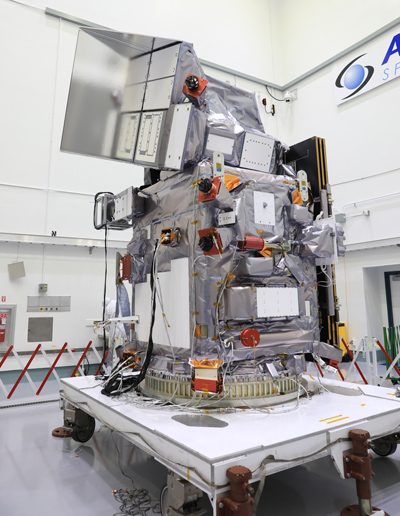On 6 February, NASA plans to launch a new satellite tasked with monitoring microbes in the ocean and aerosols in the atmosphere. The mission, called PACE (Plankton, Aerosol, Cloud, ocean Ecosystem), will improve scientists’ understanding of the carbon cycle.
The satellite houses three instruments: the Ocean Color Instrument (OCI) and two polarimeters to measure the atmosphere’s aerosol composition.
Unlike current remote sensing satellites, which measure five to seven colors, the OCI will measure the brightness of more than 200 colors, from ultraviolet to infrared. Scientists use the ocean’s color to identify the abundance of phytoplankton, which live in the upper 200 meters of the water column. Greener waters typically mean that more of these chlorophyll-containing microbes are present.

Currently, scientists struggle to distinguish between different taxonomic groups of phytoplankton. The ability of the OCI to distinguish so many different colors promises to remedy that.
“The amount of light at each wavelength is directly impacted by how much of each type of plankton is in the water,” explained Alison Chase, an optical oceanographer at the University of Washington and a member of the NASA PACE Science and Applications Team. This is because different pigments (like yellow to orange carotenoids) and cell structures absorb and scatter light differently, she said.
Different types of phytoplankton interact with the ocean and atmosphere in varying ways, said Jeremy Werdell, a project scientist for PACE and an oceanographer at NASA. Ultimately, however, phytoplankton “form the base of the aquatic food chain. They are responsible for bringing carbon dioxide out of the atmosphere,” he said.
PACE could also help answer questions about the role of phytoplankton in the carbon cycle as the world warms. “We certainly don’t know a lot yet about how different phytoplankton community groups at the surface impact carbon flux on large spatial scales,” Chase said.
Larger phytoplankton species such as diatoms live in the upper ocean but rely on cold, nutrient-rich water that upwells from the deep, for example. Warming waters could affect ocean currents, limiting the flow of nutrients. If these conditions occur, “big phytoplankton won’t have what they need to grow,” Chase said.
PACE will help scientists monitor these communities across entire ocean regions. Those data can then be used to estimate carbon flux and predict what may happen to carbon levels if those communities change, Chase said.
From Ocean to Sky
The ocean, clouds, and aerosols interact to modulate temperature in the atmosphere, Werdell said, and the PACE mission will monitor Earth’s skies as well as its seas. PACE’s polarimeters will measure how light is polarized as it passes through the atmosphere, which can indicate the amount, size, and shape of suspended particles and other properties of clouds.
“Our understanding of those interactions is really one of the largest uncertainties in our ability to interpret [climate] models.”
“Our understanding of those interactions is really one of the largest uncertainties in our ability to interpret [climate] models,” said Werdell.
In the atmosphere, aerosols seed clouds and influence droplet size. When aerosols settle in the oceans, they provide phytoplankton with nutrients. Phytoplankton even release compounds that form aerosols, which can form clouds, Werdell said. “Right now, there’s just a lot of big error bars in terms of tying that all together.” PACE data will help scientists piece together how these systems interact and how these relationships will shift with climate change.
PACE will produce so much information that it will be a challenge to use it all at first, Werdell said. “The beauty of this mission in my mind is that it’s information we can grow into in order to understand the interconnectedness of this full Earth system.”
—Emily Shepherd (@emilyshep1011), Science Writer

